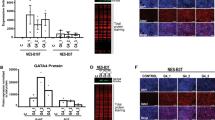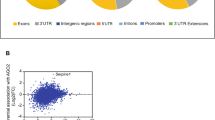Abstract
We isolated the MAL (T-lymphocyte maturation associated protein) gene from differentially expressed products of esophageal epithelium relative to esophageal carcinoma tissues. The Mal protein has been demonstrated as being a component of the protein machinery for apical transport in epithelial polarized cells. In this study, we describe the reduced expression of MAL in all 39 cases of esophageal carcinoma tested and 60 other human carcinomas. MAL gene transcription was induced in three out of 13 esophageal carcinoma cell lines by treatment with the demethylating agent 5-aza-2′-deoxycytidine (DAC), and in nine additional cell lines by simultaneous treatment with trichostatin A, an inhibitor of deacetylation, and DAC. We established a stable MAL gene transfectant whose expression was regulated by subcutaneous doxycycline injection in nude mice. Tumor growth was suppressed in cells expressing TE3-MAL compared with TE3 parent cells or cells not expressing TE3-MAL with doxycycline injection (20 μg/body) (P<0.01). Additionally, the TE3-MAL transfectant cells exhibited decreased cellular motility, a G1/S transition block and increased levels of apoptosis, concomitant with increased expression of Fas receptor in vitro. The apoptotic staining in MAL-expressing tumors was confirmed by TUNEL assay. Therefore, we conclude that expression of MAL was frequently decreased or diminished in gastrointestinal tract cancers, and that Mal expression confers reduced tumorigenicity in vivo to tumor TE3 cells through the induction of apoptosis via the Fas signaling pathway.
This is a preview of subscription content, access via your institution
Access options
Subscribe to this journal
Receive 50 print issues and online access
$259.00 per year
only $5.18 per issue
Buy this article
- Purchase on Springer Link
- Instant access to full article PDF
Prices may be subject to local taxes which are calculated during checkout







Similar content being viewed by others
References
Abbott BD, Schmid JE, Brown JG, Wood CR, White RD, Buckalew AR and Held GA . (1999). Toxicol. Sci., 47, 76–85.
Alonso MA and Weissman SM . (1987). Proc. Natl. Acad. Sci. USA, 84, 1997–2001.
Cameron EE, Bachman KE, Myohanen S, Herman JG and Baylin SB . (1999). Nat. Genet., 21, 103–107.
Cheong KH, Zacchetti D, Schneeberger EE and Simons K . (1999). Proc. Natl. Acad. Sci. USA, 96, 6241–6248.
Dong JT . (2001). Cancer Metast. Rev., 20, 173–193.
Kim T, Fiedler K, Madison DL, Krueger WH and Pfeiffer SE . (1995). J. Neurosci. Res., 42, 413–422.
Konrad M, Saunier S, Heidet L, Silbermann F, Benessy F, Calado J, Le Paslier D, Broyer M, Gubler MC and Antignac C . (1996). Hum. Mol. Genet., 5, 367–371.
Martin-Belmonte F, Arvan P and Alonso MA . (2001). J. Biol. Chem., 276, 49337–49342.
Martin-Belmonte F, Kremer L, Albar JP, Marazuela M and Alonso MA . (1998). Endocrinology, 139, 2077–2084.
Martin-Belmonte F, Puertollano R, Millan J and Alonso MA . (2000). Mol. Biol. Cell, 11, 2033–2045.
Matsuyama A, Inoue H, Shibuta K, Tanaka Y, Barnard GF, Sugimachi K and Mori M . (2001). Cancer Res., 61, 5714–5717.
Millan J and Alonso MA . (1998). Eur. J. Immunol., 28, 3675–3684.
Millan J, Puertollano R, Fan L, Rancano C and Alonso MA . (1997). Biochem. J., 321, 247–252.
Mimori K, Mori M, Shiraishi T, Fujie T, Baba K, Haraguchi M, Abe R, Ueo H and Akiyoshi T . (1997). Br. J. Cancer, 76, 531–536.
Mori M, Inoue H, Mimori K, Shibuta K, Nakashima H, Haraguchi M, Tsuji K, Ueo H, Barnard G and Akiyoshi T . (1996). Ann. Surg., 224, 183–188.
Mori M, Mimori K, Inoue H, Barnard GF, Tsuji K, Nanbara S, Ueo H and Akiyoshi, T . (1995). Cancer Res., 55, 3417–3420.
Nishihira T, Hashimoto Y, Katayama M, Mori S and Kuroki T . (1993). J. Cancer Res. Clin. Oncol., 119, 441–449.
Puertollano R and Alonso MA . (1999). Mol. Biol. Cell, 10, 3435–3447.
Puertollano R, Li S, Lisanti MP and Alonso MA . (1997). J. Biol. Chem., 272, 18311–18315.
Puertollano R, Martinez-Menarguez JA, Batista A, Ballesta J and Alonso MA . (2001). Mol. Biol. Cell, 12, 1869–1883.
Saunier S, Calado J, Benessy F, Silbermann F, Heilig R, Weissenbach J and Antignac C . (2000). Am. J. Hum. Genet., 66, 778–789.
Shibata K, Tanaka S, Shiraishi T, Kitano S and Mori M . (1999). Cancer Res., 59, 1096–1101.
Shimada Y, Imamura M, Wagata T, Yamaguchi N and Tobe T . (1992). Cancer, 69, 277–284.
Shiraishi T, Mori M, Tanaka S, Sugimachi K and Akiyoshi T . (1998). Int. J. Cancer, 79, 175–178.
Sugimachi K, Matsuoka H, Ohno S, Mori M and Kuwano H . (1988). Br. J. Surg., 75, 1115–1118.
Tugores A, Rubio T, Rancano C and Alonso MA . (1997). DNA Cell Biol., 16, 245–255.
Wadler S, Zhang H, Cammer M and Hu XP . (1999). Anal. Biochem., 267, 24–29.
Acknowledgements
We thank Dr T Shimo-oka for essential advice, Dr M Okamoto for his fruitful suggestions also and to J Miyake for excellent technical assistance.
Author information
Authors and Affiliations
Corresponding author
Rights and permissions
About this article
Cite this article
Mimori, K., Shiraishi, T., Mashino, K. et al. MAL gene expression in esophageal cancer suppresses motility, invasion and tumorigenicity and enhances apoptosis through the Fas pathway. Oncogene 22, 3463–3471 (2003). https://doi.org/10.1038/sj.onc.1206378
Received:
Revised:
Accepted:
Published:
Issue Date:
DOI: https://doi.org/10.1038/sj.onc.1206378
Keywords
This article is cited by
-
Retinoic acid receptor γ activation promotes differentiation of human induced pluripotent stem cells into esophageal epithelium
Journal of Gastroenterology (2020)
-
MAL gene overexpression as a marker of high-grade serous ovarian carcinoma stem-like cells that predicts chemoresistance and poor prognosis
BMC Cancer (2017)
-
CMTM5 is reduced in prostate cancer and inhibits cancer cell growth in vitro and in vivo
Clinical and Translational Oncology (2015)
-
The Expression Changes of Myelin and Lymphocyte Protein (MAL) Following Optic Nerve Crush in Adult Rats Retinal Ganglion Cells
Journal of Molecular Neuroscience (2014)
-
CMTM3 is frequently reduced in clear cell renal cell carcinoma and exhibits tumor suppressor activities
Clinical and Translational Oncology (2014)



